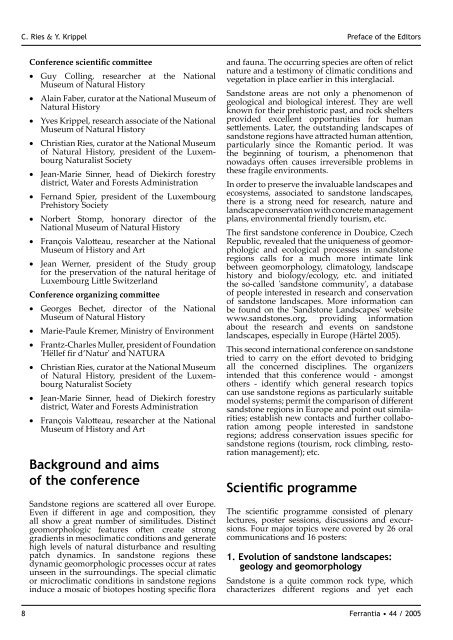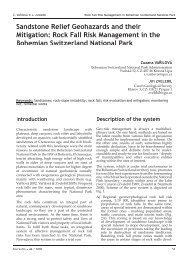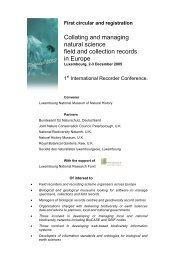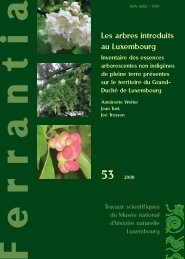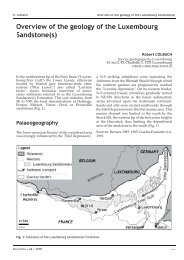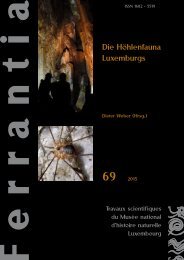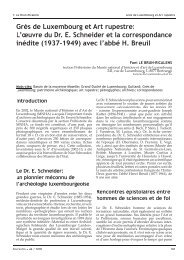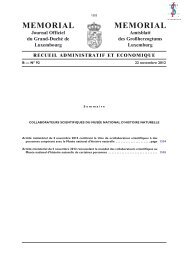Preface of the Editors - Musée national d'histoire naturelle
Preface of the Editors - Musée national d'histoire naturelle
Preface of the Editors - Musée national d'histoire naturelle
Create successful ePaper yourself
Turn your PDF publications into a flip-book with our unique Google optimized e-Paper software.
C. Ries & Y. Krippel <strong>Preface</strong> <strong>of</strong> <strong>the</strong> <strong>Editors</strong>Conference scientific commiee• Guy Colling, researcher at <strong>the</strong> NationalMuseum <strong>of</strong> Natural History• Alain Faber, curator at <strong>the</strong> National Museum <strong>of</strong>Natural History• Yves Krippel, research associate <strong>of</strong> <strong>the</strong> NationalMuseum <strong>of</strong> Natural History• Christian Ries, curator at <strong>the</strong> National Museum<strong>of</strong> Natural History, president <strong>of</strong> <strong>the</strong> LuxembourgNaturalist Society• Jean-Marie Sinner, head <strong>of</strong> Diekirch forestrydistrict, Water and Forests Administration• Fernand Spier, president <strong>of</strong> <strong>the</strong> LuxembourgPrehistory Society• Norbert Stomp, honorary director <strong>of</strong> <strong>the</strong>National Museum <strong>of</strong> Natural History• François Valoeau, researcher at <strong>the</strong> NationalMuseum <strong>of</strong> History and Art• Jean Werner, president <strong>of</strong> <strong>the</strong> Study groupfor <strong>the</strong> preservation <strong>of</strong> <strong>the</strong> natural heritage <strong>of</strong>Luxembourg Lile SwitzerlandConference organizing commiee• Georges Bechet, director <strong>of</strong> <strong>the</strong> NationalMuseum <strong>of</strong> Natural History• Marie-Paule Kremer, Ministry <strong>of</strong> Environment• Frantz-Charles Muller, president <strong>of</strong> Foundation'Hëllef fir d’Natur' and NATURA• Christian Ries, curator at <strong>the</strong> National Museum<strong>of</strong> Natural History, president <strong>of</strong> <strong>the</strong> LuxembourgNaturalist Society• Jean-Marie Sinner, head <strong>of</strong> Diekirch forestrydistrict, Water and Forests Administration• François Valoeau, researcher at <strong>the</strong> NationalMuseum <strong>of</strong> History and ArtBackground and aims<strong>of</strong> <strong>the</strong> conferenceSandstone regions are scaered all over Europe.Even if different in age and composition, <strong>the</strong>yall show a great number <strong>of</strong> similitudes. Distinctgeomorphologic features oen create stronggradients in mesoclimatic conditions and generatehigh levels <strong>of</strong> natural disturbance and resultingpatch dynamics. In sandstone regions <strong>the</strong>sedynamic geomorphologic processes occur at ratesunseen in <strong>the</strong> surroundings. The special climaticor microclimatic conditions in sandstone regionsinduce a mosaic <strong>of</strong> biotopes hosting specific floraand fauna. The occurring species are oen <strong>of</strong> relictnature and a testimony <strong>of</strong> climatic conditions andvegetation in place earlier in this interglacial.Sandstone areas are not only a phenomenon <strong>of</strong>geological and biological interest. They are wellknown for <strong>the</strong>ir prehistoric past, and rock sheltersprovided excellent opportunities for humanselements. Later, <strong>the</strong> outstanding landscapes <strong>of</strong>sandstone regions have aracted human aention,particularly since <strong>the</strong> Romantic period. It was<strong>the</strong> beginning <strong>of</strong> tourism, a phenomenon thatnowadays oen causes irreversible problems in<strong>the</strong>se fragile environments.In order to preserve <strong>the</strong> invaluable landscapes andecosystems, associated to sandstone landscapes,<strong>the</strong>re is a strong need for research, nature andlandscape conservation with concrete managementplans, environmental friendly tourism, etc.The first sandstone conference in Doubice, CzechRepublic, revealed that <strong>the</strong> uniqueness <strong>of</strong> geomorphologicand ecological processes in sandstoneregions calls for a much more intimate linkbetween geomorphology, climatology, landscapehistory and biology/ecology, etc. and initiated<strong>the</strong> so-called 'sandstone community', a database<strong>of</strong> people interested in research and conservation<strong>of</strong> sandstone landscapes. More information canbe found on <strong>the</strong> 'Sandstone Landscapes' websitewww.sandstones.org, providing informationabout <strong>the</strong> research and events on sandstonelandscapes, especially in Europe (Härtel 2005).This second inter<strong>national</strong> conference on sandstonetried to carry on <strong>the</strong> effort devoted to bridgingall <strong>the</strong> concerned disciplines. The organizersintended that this conference would - amongsto<strong>the</strong>rs - identify which general research topicscan use sandstone regions as particularly suitablemodel systems; permit <strong>the</strong> comparison <strong>of</strong> differentsandstone regions in Europe and point out similarities;establish new contacts and fur<strong>the</strong>r collaborationamong people interested in sandstoneregions; address conservation issues specific forsandstone regions (tourism, rock climbing, restorationmanagement); etc.Scientific programmeThe scientific programme consisted <strong>of</strong> plenarylectures, poster sessions, discussions and excursions.Four major topics were covered by 26 oralcommunications and 16 posters:1. Evolution <strong>of</strong> sandstone landscapes:geology and geomorphologySandstone is a quite common rock type, whichcharacterizes different regions and yet each8Ferrantia • 44 / 2005


